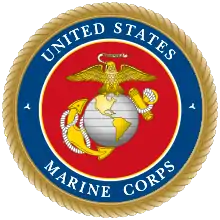VMA-311
Marine Attack Squadron 311 (VMA-311) was a United States Marine Corps attack squadron consisting of AV-8B Harrier (V/STOL) jets. Known as the "Tomcats", the squadron was based at Marine Corps Air Station Yuma, Arizona and prior to decommissioning fell under the command of Marine Aircraft Group 13 (MAG-13) and the 3rd Marine Aircraft Wing (3rd MAW).
| Marine Attack Squadron 311 | |
|---|---|
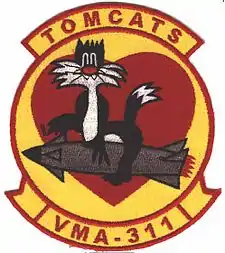 VMA-311 insignia | |
| Active | December 1, 1942 - October 15, 2020[1] |
| Country | United States |
| Allegiance | United States of America |
| Branch | United States Marine Corps |
| Type | Attack |
| Role | Close air support Air interdiction Aerial reconnaissance |
| Nickname(s) | Tomcats Hells Belles (WWII) |
| Tail Code | WL |
| Engagements | World War II * Battle of Okinawa Korean War * Attack on the Sui-ho Dam Vietnam War * Operation Starlite Operation Desert Storm Operation Enduring Freedom Operation Iraqi Freedom * 2003 invasion of Iraq |
| Aircraft flown | |
| Fighter | SNJ Texan F4U Corsair TO-1 Shooting Star F9F Panther F9F Cougar A4D-2 Skyhawk AV-8B Harrier II |
History
World War II

Marine Fighting Squadron 311 (VMF-311) was first commissioned on 1 December 1942 under Major Ralph K. Rottet, assigned to the 3rd Marine Aircraft Wing and headquartered at MCAS Cherry Point.[2]:1[3] Quickly transitioning from a training squadron flying the SNJ Texan to a combat squadron flying the F4U Corsair, VMF-311 participated in what was one of the earliest American catapult operations involving the Corsair when 21 F4Us launched from USS Nassau on October 6, 1943. By this time the squadron formed part of MAG-31. During World War II, VMF-311 was one of the first to utilize and develop tactics for the Corsair in a ground attack mode, foreshadowing the squadron’s future role as an attack squadron. Indicative of its combat effectiveness the squadron destroyed 71[4][5] Japanese aircraft in a four-month period during the Battle of Okinawa in 1945. The end of World War II saw VMF-311 leaving Chimu Airfield on Okinawa to start occupational duty flying from Yokosuka airfield on Japan's mainland.
1946-1950
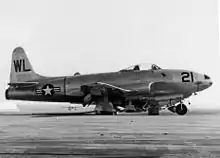
Occupational duty in Japan lasted till May 1946, when MAG-31 was notified to prepare for the termination of its Japanese assignment; VMF-311 was going home.[2]:11 Between July 1946 and April 1947 the squadron had a sleeping existence and being transferred to MAG-32 and later MAG-12 while consisting of one officer, but in 1949 VMF-311 became the first West Coast Marine jet squadron when it started flying the TO-1 Shooting Star. Coincidentally the squadron was re-designated Marine Fighter Squadron 311 (VMF-311) and around that time acquired the code letters WL, phonetically pronounced as "William Love," but from which also came the nickname "Willy Lovers".[2]:14 The squadron quickly transitioned to the F9F Panther in October 1949 and found itself once again preparing for war by November 1950, arriving once again at Yokusuka airfield in Japan.
The Korean War, 1950–1955
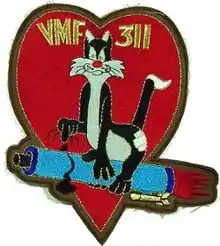
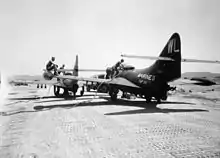
Arriving in South Korea on December 7, 1950, VMF-311 was the first land-based Marine jet squadron to be used in combat providing close air support for the Marines and Soldiers on the ground.[6] In late-June 1952 the squadron participate in the attack on the Sui-ho Dam. Additionally, the squadron pioneered strip-alert tactics still practiced today. Legendary pilots during this era included later astronaut and Senator John Glenn and baseball star Ted Williams. In over 2 1⁄2 years of action in Korea the squadron amassed 18,851 combat sorties. In 1957, the squadron finally was re-designated Marine Attack Squadron 311 (VMA-311). The nickname "Tomcats" was also bestowed during this era.
Vietnam War

The first A4D-2 Skyhawk was received in the summer of 1958, initiating 30 years of Skyhawk service. In May 1965 the squadron, now flying A-4Es, deployed to Chu Lai Air Base, South Vietnam and on June 2, they conducted their first combat mission of the Vietnam War. In August 1965, VMA-311 supported the 7th Marine Regiment in Operation Starlite, the first major American operation of the war.[2]:41 The squadron recorded a four-day sortie total of 240 from 5 to 8 May 1968 in support of their fellow marines during the Battle of Khe Sanh.[7]
The squadron moved to Danang Air Base in late July 1970.[2]:51 In early 1971 the squadron provided support for Operation Lam Son 719 the South Vietnamese offensive into Laos and was credited with destroying eight People's Army of Vietnam tanks.[2]:52 During may 1971 the squadron readied for redeployment, flying their last mission on 7 May before leaving South Vietnam on 12 May.[2]:52
The squadron rejoined Marine Aircraft Group 12 (MAG-12) at MCAS Iwakuni with the entire squadron redeployed by 27 May 1971.[2]:52 On 29 October the squadron deployed to Naha Air Base until 15 January 1972.[2]:53
On 16 May 1972 VMA-311 once again deployed to South Vietnam with MAG-12 Forward and VMA-211 to Bien Hoa Air Base in response to the North Vietnamese Easter Offensive. The squadron would support Army of the Republic of Vietnam forces fighting in the Battle of An Loc.[2]:53 Their final sortie in-country would occur on January 29, 1973, a day before they would drop the last ordnance from a Marine A-4 Skyhawk during the war. VMA-311 would fly 54,625 combat sorties during their time supporting operations in Vietnam, Laos and Cambodia.[8]
The Gulf War
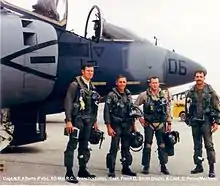
In 1988 VMA-311 received its first AV-8B Harrier and shortly thereafter headed into harm's way again. On August 11, 1990, after the Iraqi invasion of Kuwait, VMA-311 deployed in support of Operation Desert Shield, leading all other Marine fixed-wing squadrons into Saudi Arabia where they were based out of King Abdulaziz Naval Base. While there, the Tomcats were the most forward deployed fixed-wing squadron. On January 17, 1991 while in support of Operation Desert Storm the squadron became the first to utilize the AV-8B in combat when a flight of four Harriers destroyed an Iraqi artillery position in support of the Battle of Khafji. During 43 days of air combat operations, Tomcat pilots flew 1,017 combat missions and delivered 840 tons of ordnance against enemy targets throughout Kuwait and Southern Iraq.
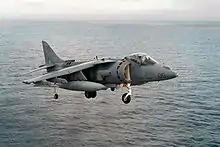
Global War on Terror
On November 3, 2001, VMA-311 Harriers attached to the 15th Marine Expeditionary Unit embarked aboard USS Peleliu became the first Harriers to fly combat missions in Afghanistan during Operation Enduring Freedom.
On January 15, 2003, VMA-311 deployed to the Northern Persian Gulf as part of Amphibious Task Force West. On March 21, 2003, almost 59 years to the day after VMF-311’s first combat sortie in World War II, they flew their first combat sortie of Operation Iraqi Freedom. During the war they flew over 550 sorties while dropping 77 tons of precision ordnance, destroying or neutralizing 132 Iraqi targets while operating from two amphibious assault carriers, USS Bonhomme Richard and USS Tarawa. The squadron returned from the Persian Gulf on July 24, 2003. In early 2005, the squadron deployed to Al Asad Air Base in Iraq in support of Operation Iraqi Freedom, while simultaneously deploying a 6 jet 90 Marine detachment to MAG-12 in Iwakuni, Japan to support the 31st Marine Expeditionary Unit. In early 2008, the squadron made its final deployment to Al Asad Air Base in support of Operation Iraqi Freedom, while simultaneously deploying a 6 jet detachment aboard the USS Peleliu (LHA 5) in support of the 15th Marine Expeditionary Unit. The squadron's 2008 deployment to Iraq marked the Marine Corps Harrier's final participation in Operation Iraqi Freedom, and on 5 October 2008, VMA-311's aircraft were the last Harriers to fly combat missions in support of Operation Iraqi Freedom. For the year 2008, VMA-311 had the distinction of being selected as the Marine Corps "Attack Squadron of the Year" by the Marine Corps Aviation Association (MCAA). Operation Iraqi Freedom deployments were soon followed in 2010 with deployments again to the 15th MEU and a Unit Deployment Program to the Pacific region. While there, they spent over two months aboard USS Essex with the 31st MEU while participating in the multilateral exercises Cobra Gold 2010 and Balikatan 2010. VMA-311 deployed to Camp Bastion, Helmand Province, Afghanistan in support of Operation Enduring Freedom from April to September 2013.
Squadron aces
The following Marines from VMA-311 have been credited as Flying aces:[10]
- 2nd Lt. William P. Brown Jr. - 7.0
- Maj. Michael R. Yunck - 7.0 (5.0 with VMA-311)[11]
- Maj. Perry L. Shuman - 6.0
See also
| Wikimedia Commons has media related to VMA-311. |
- United States Marine Corps Aviation
- List of United States Marine Corps aircraft squadrons
References
 This article incorporates public domain material from websites or documents of the United States Marine Corps.
This article incorporates public domain material from websites or documents of the United States Marine Corps.
Citations
- Barison, Gabriele (October 21, 2020). "VMA-311 Deactivated as USMC Retires Iconic Harrier Jump Jet. Tomcats Will Reactivate as VMFA-311 Operating The F-35C Lightning II". theaviationgeekclub.com. Retrieved October 25, 2020.
- Sambito, William (1978). A History of Marine Attack Squadron 311 (PDF). History and Museums Division, United States Marine Corps. ISBN 9781481996655.
 This article incorporates text from this source, which is in the public domain.
This article incorporates text from this source, which is in the public domain. - 3d MAW General Order 2-1942 Commissioning VMF-311 on 1 December 1942
- Tillman 1979, p. 152.
- Styling 1995, p. 80.
- http://collections.naval.aviation.museum/emuwebdoncoms/pages/doncoms/Display.php?irn=16001491&QueryPage=%2FDtlQuery.php Archived 2008-12-22 at the Wayback Machine National Museum of Naval Aviation
- Dorr Marine Air, p.205.
- Mersky (1983), p.281.
- "2018 Marine Aviation Plan" (PDF). Marines.mil. 2018.
- List of WW2 Marine Aces, www.acepilots.com, 21 December 2007
- Styling 1995, pp. 87-90.
Bibliography
- Doll, Thomas E. Flying Leathernecks in World War II. Fallbrook, California: Aero Publishers, Inc., 1971. ISBN 0-8168-0312-9.
- Dorr, Robert F. Marine Air - The History of the Flying Leathernecks in Words and Photos. Penguin Books, 2005. ISBN 0-425-20725-0.
- Mersky, Peter B. (1983). U.S. Marine Corps Aviation - 1912 to the Present. Nautical and Aviation Publishing Company of America. ISBN 0-933852-39-8.
- Sherrod, Robert. History of Marine Corps Aviation in World War II. Combat Forces Press, 1952. ISBN 0-933852-58-4.
- Styling, Mark. Corsair Aces of World War 2. Botley, Oxford, UK: Osprey Publishing, 1995. ISBN 1-85532-530-6.
- Tillman, Barrett. Corsair: the F4U in World War II and Korea. Annapolis, Maryland: United States Naval Institute Press, 1979. ISBN 0-85059-427-8.
